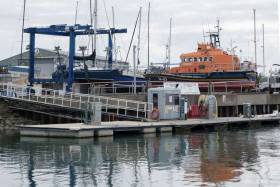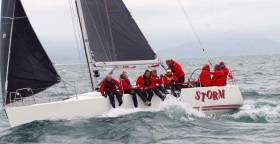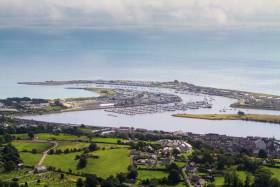Displaying items by tag: Pwllheli
Pwllheli Lifeboat Station Closes Over ‘Disharmony’ Between Crew Members
Pwllheli RNLI has closed over “ongoing distrust and disharmony” between crew members at the North Wales lifeboat station.
According to BBC News, a number of key personnel have also resigned from the station, prompting the RNLI to “reset operations”.
“Until we’ve got a safe number of crew and a safe management structure to support that lifeboat station, we’re not able to go back on to service,” said the RNLI’s Wales manager Ryan Jennings.
A statement from the RNLI said its decision to close the Pwllheli station was “not taken lightly but is considered necessary to move forward with an inclusive and sustainable lifeboat station…for many years to come”.
Pwllheli is a regular haunt for Irish sailors taking part in the annual ISORA races.
BBC News has more on the story HERE.
Pwllheli Sailing Club Honours ISORA Mainstay Richard Tudor With Lifetime Contribution Award
A Welsh sailor with a longtime connection to offshore racing in the Irish Sea has been recognised by his home club with a lifetime contribution award.
Richard Tudor was presented with the accolade recently at a special function hosted by Pwllheli Sailing Club, which has posted a glowing tribute on its website.
A fixture on the ISORA calendar, most recently in the J125, Jackknife — and a former champion in the J109, Sgrech, too — Richard has been a part of Pwllheli’s club since its first clubhouse, after a childhood growing his love of the water under the tutelage of Gwyndaf Hughes.
Sailing also runs in the family, with his father Huw serving as Pwllheli’s commodore for a time and his brothers Andrew and Stephen also keen helmsmen.
Richard sailed his first ISORA in 1976, and his first Fastnet Race in 1977 — the beginnings of a decades-long connection with Ireland’s offshore sailing scene that continues to this day. Pwllheli Sailing Club has much more HERE.
Pwllheli Marina Gets 24 Hour Self-Service Fuel Pump
A new 24-hour self-service fuel pump and payment system has been installed at Hafan Pwllheli marina in North Wales. Berth holders and visitors to the Irish Sea facility can now serve themselves petrol and diesel when it suits them.
The payment system accepts any credit or debit card.
Located on the existing fuel quay pontoon, the standalone and sturdy HTEC Outdoor Payment Terminal is linked to two pumps that both serve petrol and diesel. The system has a user-friendly, full-colour screen with customer prompts.
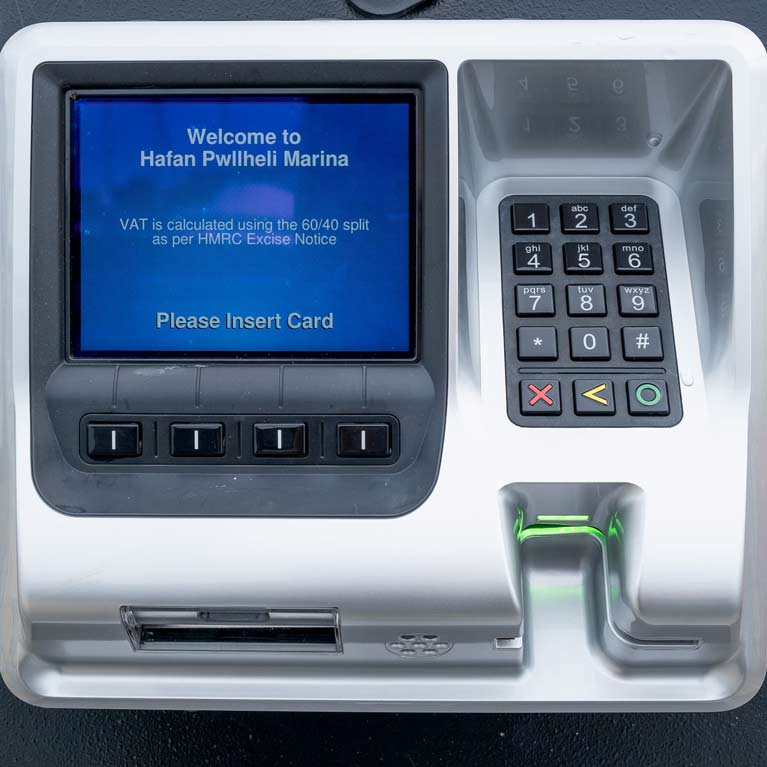
Wil Williams, Hafan Pwllheli Harbour Manager said: "Our new self-service fuel pumps are now successfully up and running after an initial trial period. After four weeks of operation, we can report the facility is proving very popular with berth holders and visitors alike. Everyone is enjoying the convenience of having fuel available 24/7.”
Under HMRC regulations, mariners must declare how much diesel they intend to use for propulsion as opposed to heating or electricity generation. Provided the fuel buyer is happy to accept the automatic onscreen 60:40 split option on the HTEC payment terminal, self-service diesel is available. If a different diesel fuel split is required, a member of the Hafan team is required to complete the sale during normal service hours.
Added Wil Williams: “Installing self-service fuel pumps is part of our ongoing commitment to improving the services on offer at Pwllheli. In recent weeks we have also completed dredging works in the main harbour channel and marina basin and improved WiFi coverage on the pontoons by installing additional booster aerials.”
2019 IRC Welsh Nationals Set For 9-11 August
Save the dates 9 to 11 August 2019 in your calendar for the Spinlock IRC Welsh National Championships, which promises a long weekend packed full of great racing and fun ashore
Once again the Welsh Nationals have been selected as the Welsh leg of the RC35 class Celtic Cup, won in 2018 by Irish boat Storm.
The Welsh National Sailing Academy and Events Centre in Pwllheli looks forward to welcoming sailors from across the UK and Ireland for racing in the world-renowned waters of Cardigan Bay, with the majestic backdrop of the mountains of Snowdonia and the rugged coastline of the Llyn Peninsula.
The championships will feature two separate race courses, one for the IRC fleets and Sportsboat class and a separate course for the Cruiser class, so there will be something for everyone.
The Notice of Race and entry form are now available online. IRC certificates are not required at this time, only basic details and general information about your boat.
All entries made before Thursday 31 January will be included in a super early-bird prize draw with Spinlock goodies to be won.
Events pontoons will once again be available for use before and during the championship without any additional charges. Book your space now in the entry form.
Berthing will also be available for boats competing in the ISORA race from Dun Laoghaire to Pwllheli on Saturday 27 July for those who wish to leave their boat in Pwllheli ready off the IRC Championships.
This year the camping facilities at the academy will be available for participants. Bring your campervan or caravan to set up your base camp right on the venue site. More details and online booking can be found on the Plas Heli website.
There will also be a limited number of bunk beds available on on a first come, first served basis. Details about this added facility will be circulated to entered boats first.
Organisers will arrange shore storage so that your delivery sails, life-rafts and associated gear can be stored for the duration of the event. Please indicate on the entry form if you would like shore storage.
And of course, there will be a full social programme ashore. Details will be circulated by e-newsletter and published on the official championship website in due course.
Dredging Works at Hafan Pwllheli Marina in North Wales
Important dredging work at Hafan Pwllheli marina in North Wales has been scheduled for 2018. The plan to dredge the harbour entrance and the main channel to maintain its design depth has already been agreed. Work on clearing the entrance of silt using land-based machinery will start on 9th April. This is expected to take a few weeks.
The following month a tug boat equipped with bed leveling machinery will be employed to remove any bumps in the main channel that runs through the outer harbour. Dredging will then stop over the summer months to minimise disruption to berth holders.
More extensive dredging of the marina basin itself is then planned for October 2018. This was last carried out four years ago when 90,000 cubic metres of dredged material were removed from the harbour.
Wil Williams, Hafan Pwllheli Marina Manager said: "We are pleased to report that dredging of the entrance will begin in April, moving on to the channel levelling work in May. This is routine work and part of our ongoing maintenance programme. During the winter months we can get a build up of silt at the entrance and high spots in the channel. This has to be remedied periodically. Once this is complete, the entrance and channel will be returned to the designed depth of 0.5m below Chart Datum, providing excellent access to the marina for most yachts at virtually all states of the tide.
"Later in the year, we will commence work on dredging the inner harbour and marina basin. This is a major undertaking because boats at the marina will have to be moved to alternative pontoons during each phase of the dredging programme. However, we feel this work is important to ensure that our facilities continue to be of the highest standard."
ISORA & DBSC Ready to Kick off The Summer Sailing Season
The annual 'lift–in' of yachts at the four waterfront yacht clubs at Dun Laoghaire Harbour last weekend means one thing: there is just two weeks until the first races of the summer sailing season on Dublin Bay.
Up to 300 boats ranging from ten–foot dinghies right up to 50–foot ocean-going keelboats will compete in a variety of separate series and regattas.
The first of which is the ISORA offshore series of the year. It begins on Saturday, April 22nd. The following Tuesday, April 25th, the Sherry Fitzgerald sponsored Dubin Bay Sailing Club (DBSC) season gets underway. Read Commodore Chris Moore's season preview here.
ISORA sees action on both sides of the Irish Sea. Firstly there is a coastal race from Pwllheli sponsored by Global, forming part of the Global displays Welsh coastal series, and the full ISORA series and simultaneously a coastal race from Dun Laoghaire to Wicklow, sponsored by Viking Marine forming part of the RAYC coastal series and of course the full ISORA series.
Both races will be tracked by Yellow brick trackers.
#isora – After a frustrating weekend of racing on the Irish Sea it was Welsh yachts from Pwllheli that took the upper hand in race five of the ISORA series last night. In a 100–mile race from Doulgas in the Isle of Man to Dun Laoghaire, a fleet of 20 boats started from the Manx capital on Sunday morning at 0630 hours but it took took the bulk of the fleet over 12 hours to reach the outer limits of Dublin Bay with four retirals to boot.
The J125 Jackknife (Andrew Hall) with an elapsed time of 11 hours 10 minutes and 38 seconds was the first to enounter the vagaries of the Bay. It was enough to give him a clear handicap win in IRC one and IRC overall. Next in to Dublin was local boat Lively Lady, a Beneteau 44.7 from the Royal Irish Yacht Club skippered by Rodney Martin to take a well earned second on the water but it was the Welsh J109 Mojito (P. Dunlop and V.Cox) in an elapsed time of 13.02.27 that took second on handicap in IRC one and second overall.
Full results for both the ISORA race 4 from Holyhead to Douglas last Friday and the race to Dun Laoghaire are downloadable below as pdf files.
#allwalesboatshow – Irish Yacht Broker BJ Marine is making good on its latest base on the Irish Sea by becoming the largest exhibitor at the All Wales Boat Show, opening in Pwllheli this morning and running til Sunday.
Having opened its office in Pwllheli in December, General Manager James Kirwan told Afloat.ie 'we are very proud of the display we have put together with 11 boats at the show'.
The BJ Marine boats exhibited are some of Beneteau's newest and most popular models (list below). BJ also has 200 boats promoted at its brokerage stand ashore. BJ Marine has a six strong team on site for the duration of the show and look forward to welcoming all visitors.
The move in to Wales gives BJ Marine waterside locations and facilities at Bangor marina in County Down where it operates the marina boatyard, its head office at the new Greystones marina in Wicklow and now on the far side of the Irish Sea at Gwynedd in North Wales.
The marina in Pwllheli boasts 400 berths and storage for a further 200 boats ashore, which played a big part in BJ Marine's commitment to set up office there.
Beneteau are dealers for Beneteau power and sail, Monte Carlo yachts, Sea Ray and Fountaine Pajot. They have offices in Ireland, UK and Malta.
On Display in Wales
Beneteau Oceanis 48
Beneteau Oceanis 38
Beneteau Oceanis 35
Beneteau First 40
Beneteau First 30
Beneteau Antares 30
Beneteau Antares 780
Beneteau Barracuda 9
Beneteau Antares 580
Beneteau Swift Trawler 44
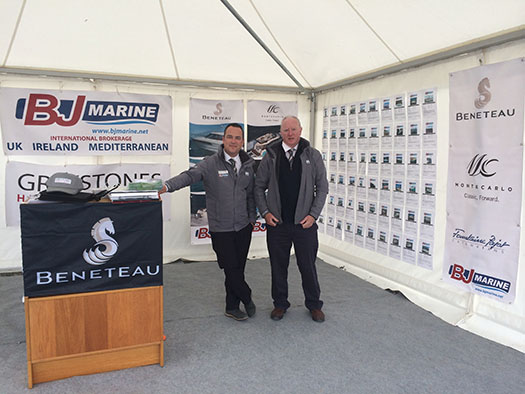
James Kirwan (left) and Bernard Gallagher at the BJ Marine brokerage stand this morning at the All Wales Boat Show
#Bjmarine – In a busy year for BJ Marine on both sides of the Irish Sea, the leading Irish boats sales firm has opened a new office in Pwllheli, North Wales to "give an unrivalled presence in the Irish Sea", according to the firm's Bernard Gallagher.
The move gives BJ Marine waterside locations and facilities at Bangor marina in County Down where it operates the marina boatyard, its head office at the new Greystones marina in Wicklow and now on the far side of the Irish Sea at Gwynedd in North Wales.
The marina in Pwllheli boasts 400 berths and storage for a further 200 boats ashore, which played a big part in BJ Marine's commitment to set up office there.
With a rich cruising ground and plenty of traffic across the Irish Sea, its no surprise that Gallagher says he's "extremely excited for the future of our Pwllheli office and the opportunities for customers on both sides of the Irish Sea."
Mike Caplan is managing the Pwllheli sales operation, bringing to the team over 16 years experience in both new and used boat sales, with Dickies in Wales and with BJ Marine on the Beneteau stand at numerous international boat shows over the years.
Caplan will be at the London Boat Show on 9-18 January to share his knowledge and help you find the right boat for your needs.
Wales Boat Show Moves to Pwllheli in 2015
#pwllheli – Wales' biggest boat show moves to Pwllheli in 2015 - Wales' deputy tourism minister welcomes news of show's return
A boating and watersports show will return to North Wales next year thanks to growing interest in the event, it was announced today.
The All Wales Boat Show 2015 will take place in Pwllheli as one of the first events at Plas Heli, the new Welsh National Sailing Academy and Events Centre.
It follows two highly successful years in Conwy where it gained considerable interest from the marine and tourism sectors and attracted thousands of visitors over several days.
Organisers believe the All Wales Boat Show plugs a hole in the market and helps highlight the huge potential in Wales, where the marine leisure industry still only accounts for 2.4% of the UK as a whole, according to the British Marine Federation (BMF).
Ken Skates, Deputy Minister for Culture, Sport and Tourism welcomed the news. He said: "Building on the previous successes of this event, I am delighted that Pwllheli will be hosting the 2015 All Wales Boat Show. It is a wonderful opportunity to showcase Plas Heli, the town's £8.3m sailing academy and events centre.
"The marine leisure industry in Wales is a major player in terms of economic development and the Welsh Government is determined to see the marine leisure industry grow and endeavour to ensure that coastal communities will benefit from this expanding market."
The 2015 All Wales Boat Show will take place from Friday May 8th to Sunday 10th May.
Davina Carey-Evans, Managing Director of Wales Watersports International which operates the All Wales Boat Show, said opportunities were now open for sponsors, exhibitors and supporters.
Those already onboard include marine specialists GJW Insurance, Royal Yachting Association (RYA) Wales/Cymru, and marine law experts Hill Dickinson.
Davina said the show was indebted to Conwy and Deganwy Quay marinas for establishing the spectacle as an annual event.
"We have enjoyed two great years in Conwy but such was the success of this year's event we simply need more space for 2015," she said.
"Pwllheli offers this but keeps the event in Wales, close to some of this country's best coastline and inland waters, and to local economies which this sector supports.
2015 will be a big year for Pwllheli and the Llyn Peninsula with the opening of Plas Heli, the new Welsh National Sailing Academy and Events Centre, which has received an £8.3 million investment from the European Regional Development Fund through the Welsh Government and Gwynedd Council.
Davina added: "Wales has a spectacular, scenic coastline of natural beauty with many safe anchorages, harbours and marinas. The capacity for growth is recognised and if nurtured sensitively will provide excellent potential to stimulate the economies of coastal communities.
"We believe the show can be a big success, and put down a real marker for the huge potential of the marine sector in Wales and the positive impact it can have on our economy as a whole."
The All Wales Boat Show is designed to appeal to local, regional and international visitors.
In 2014 thousands flocked to the three-day event at Conwy Quay marina, which featured luxury yachts through to power boats, coracles and even bath tubs.
Boats were on show from Fairline Wales, Hanse, Jeanneau, Beneteaeu, Robalo, Chapparal, Quicksilver, Sunseeker and Bayliner, plus over 100 used vessels. The first boat was sold within minutes of the event opening its doors to the public.
According to the BMF, the marine leisure sector supported 7,600 full time-equivalent jobs in Wales in 2013.
With events such as the All Wales Boat Show, developments such as Plas Heli and marina expansions, these numbers are set to increase.
In addition to the All Wales Boat Show website at www.allwalesboatshow.com a new site, www.waleswatersports.com has been launched by the show organisers to act as a major portal for the marine and watersports sector in Wales.




























